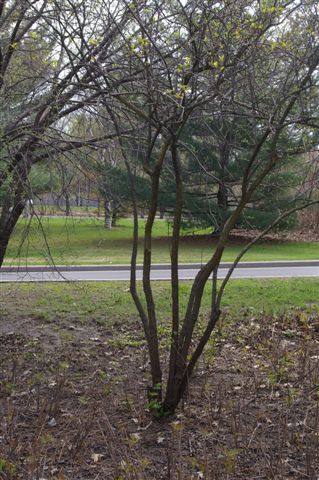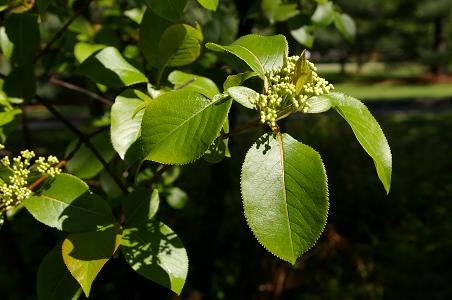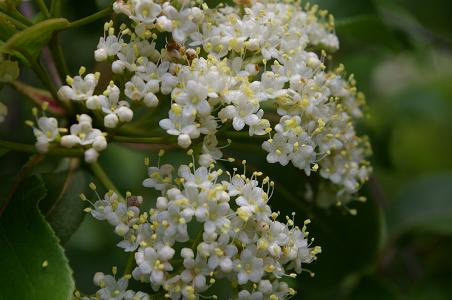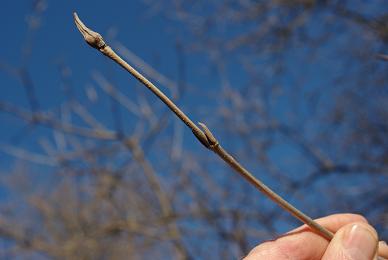GLEBE TREES AND SHRUBS
Nannyberry (Viburnum lentago)
Full tree
 April 26, 2008 opposite 502 Queen Elizabeth Drive.
There is a series of nannyberries along this stretch of QE Drive. They are growing in clumps like this, the trunks
tend to make odd sudden right angle turns. They look like the legs of a colt or fawn. The buds are long, grey
and apparently without scales. They look like a long beak, or a drawn-out Q-tip.
April 26, 2008 opposite 502 Queen Elizabeth Drive.
There is a series of nannyberries along this stretch of QE Drive. They are growing in clumps like this, the trunks
tend to make odd sudden right angle turns. They look like the legs of a colt or fawn. The buds are long, grey
and apparently without scales. They look like a long beak, or a drawn-out Q-tip.
Leaves and flowers

 May 10 and 22, 2008 opposite 502 Queen Elizabeth Drive.
May 10 and 22, 2008 opposite 502 Queen Elizabeth Drive.
 May 31, 2008
May 31, 2008
Buds
 March 19, 2009, opposite 502 Queen Elizabeth Drive.
Very long soft tapering grey buds.
March 19, 2009, opposite 502 Queen Elizabeth Drive.
Very long soft tapering grey buds.
Notes
The leaves were just emerging April 26, and the green beginnings of the central flower bunch can be seen between
some sets of leaves. On May 10, more developed. Note the winged petiole.
Nannyberry are viburnums. Opposite-leaved. The leaves themselves have a distinctly winged petiole. My mnemonic
for deciduous opposite-leaved trees is MANHanDLE: maples-ash-nannyberry (as representative of viburnums)-honeysuckle-
dogwood-lilac-elder (American elder and eastern red elderberry). Of these, ash and elders have truly compound leaves,
the elders differentiated by small size, and with toothed leaves.
Similar species
Nannyberry resembles lilac or chokecherry from a distance, but is toothed and has a very distinctively
winged petiole and are oppositely arranged. Other viburnums in this area have leaves that are quite different either in
shape (higbush cranberry) or in texture (wild raisin). Dogwoods also have opposite, oval leaves but again without teeth,
and with their particular vein pattern.
List of trees and shrubs with opposite, simple, toothed leaves
 April 26, 2008 opposite 502 Queen Elizabeth Drive.
There is a series of nannyberries along this stretch of QE Drive. They are growing in clumps like this, the trunks
tend to make odd sudden right angle turns. They look like the legs of a colt or fawn. The buds are long, grey
and apparently without scales. They look like a long beak, or a drawn-out Q-tip.
April 26, 2008 opposite 502 Queen Elizabeth Drive.
There is a series of nannyberries along this stretch of QE Drive. They are growing in clumps like this, the trunks
tend to make odd sudden right angle turns. They look like the legs of a colt or fawn. The buds are long, grey
and apparently without scales. They look like a long beak, or a drawn-out Q-tip.

 May 10 and 22, 2008 opposite 502 Queen Elizabeth Drive.
May 10 and 22, 2008 opposite 502 Queen Elizabeth Drive.
 May 31, 2008
May 31, 2008
 March 19, 2009, opposite 502 Queen Elizabeth Drive.
Very long soft tapering grey buds.
March 19, 2009, opposite 502 Queen Elizabeth Drive.
Very long soft tapering grey buds.